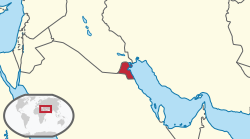Sheikhdom of Kuwait
| Sheikhdom of Kuwait | ||||||||||
|
مشيخة الكويت Mshīkha al-Kuwayt |
||||||||||
| Independent state, Protectorate of the British Empire from (1899–1961) | ||||||||||
|
||||||||||
|
||||||||||
|
Location of Kuwait in the Middle East.
|
||||||||||
| Capital | Kuwait City | |||||||||
| Languages | Kuwaiti Arabic | |||||||||
| Religion | Islam | |||||||||
| Government | Sheikhdom | |||||||||
| Historical era | 18th-20th centuries | |||||||||
| • | Established | 1752 | ||||||||
| • | Disestablished | 1961 | ||||||||
| Area | ||||||||||
| • | 1920 | 17,820 km² (6,880 sq mi) | ||||||||
| Population | ||||||||||
| • | 1920 est. | 50,000 | ||||||||
| Density | 2.8 /km² (7.3 /sq mi) | |||||||||
| • | 1961 est. | 321,600 | ||||||||
| Density | 18 /km² (46.7 /sq mi) | |||||||||
| Currency | Kuwaiti dinar | |||||||||
|
||||||||||
| Today part of |
|
|||||||||
The Sheikhdom of Kuwait (مشيخة الكويت Mshīkha al-Kuwayt) was a Sheikhdom which gained independence from the Emirate of Al Hasa in the year 1752. The Sheikhdom became a British protectorate between 1899 and 1961 after the Anglo-Kuwaiti agreement of 1899 was signed between Sheikh Mubarak Al Sabah and the British government in India due to severe threats to Kuwait's independence from the Ottoman Empire.
Kuwait was founded in 1613 AD as a fishing village known as Grane. The region soon came under the rule of the Bani Khalid in 1670 after the expulsion of the Ottomans from Eastern Arabia by Barrack bin Ghurayr, Emir of the Bani Khalid who successfully besieged the Ottoman governor Umar Pasha who surrendered and gave up his rule as the fourth Ottoman governor of al-Hasa.
The families of the Bani Utbah finally arrived in Kuwait in 1713 AD and settled after receiving permission from the Emir of al-Hasa Sa'dun bin Muhammad who ruled from 1691-1722 AD. The Utubs didn't immediately settle in Kuwait however, they roamed for half a century before finally settling. They first left the region of Najd in central Arabia and settled themselves in what is now Qatar, after a quarrel between them and some of the inhabitants of the region they departed and settled near Umm Qasr living as brigands, raiding passing caravans and levying taxes over the shipping of the Shatt al-Arab. Due to these practices, they were driven out of the area by the Ottoman Mutasallim of Basra and later lived in Sabiyya an area bordering the north of Kuwait Bay, until finally requesting permission from the Bani Khalid to settle in Kuwait which was then under the rule of the Emir of al-Hasa who himself was of the Bani Khalid.
In 1718, the head of each family in the town of Kuwait gathered and chose Sabah I bin Jaber as the Sheikh of Kuwait becoming a governor of sorts underneath the Emir of Al Hasa. During this time as well, the power in governance was split between the Al Sabah, Al Khalifa, and Al Jalahma families in which the Al Sabah will have control over the reins of power whereas the Al Khalifa were in charge of trade and the flow of money, and the Jalahma would be in charge over work in the sea.
In 1752, Kuwait became independent after an agreement between the Sheikh of Kuwait and the Emir of Al Hasa in which Al Hasa recognized Sabah I bin Jaber's independent rule over Kuwait and in exchange Kuwait would not ally itself or support the enemies of Al Hasa or interfere in the internal affairs of Al Hasa in any way.
...
Wikipedia



